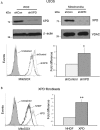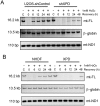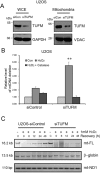XPD localizes in mitochondria and protects the mitochondrial genome from oxidative DNA damage
- PMID: 25969448
- PMCID: PMC4477675
- DOI: 10.1093/nar/gkv472
XPD localizes in mitochondria and protects the mitochondrial genome from oxidative DNA damage
Abstract
Xeroderma pigmentosum group D (XPD/ERCC2) encodes an ATP-dependent helicase that plays essential roles in both transcription and nucleotide excision repair of nuclear DNA, however, whether or not XPD exerts similar functions in mitochondria remains elusive. In this study, we provide the first evidence that XPD is localized in the inner membrane of mitochondria, and cells under oxidative stress showed an enhanced recruitment of XPD into mitochondrial compartment. Furthermore, mitochondrial reactive oxygen species production and levels of oxidative stress-induced mitochondrial DNA (mtDNA) common deletion were significantly elevated, whereas capacity for oxidative damage repair of mtDNA was markedly reduced in both XPD-suppressed human osteosarcoma (U2OS) cells and XPD-deficient human fibroblasts. Immunoprecipitation-mass spectrometry analysis was used to identify interacting factor(s) with XPD and TUFM, a mitochondrial Tu translation elongation factor was detected to be physically interacted with XPD. Similar to the findings in XPD-deficient cells, mitochondrial common deletion and oxidative damage repair capacity in U2OS cells were found to be significantly altered after TUFM knock-down. Our findings clearly demonstrate that XPD plays crucial role(s) in protecting mitochondrial genome stability by facilitating an efficient repair of oxidative DNA damage in mitochondria.
© The Author(s) 2015. Published by Oxford University Press on behalf of Nucleic Acids Research.
Figures








Similar articles
-
Role of Xeroderma pigmentosum D (XPD) protein in genome maintenance in human cells under oxidative stress.Mutat Res Genet Toxicol Environ Mutagen. 2022 Apr-May;876-877:503444. doi: 10.1016/j.mrgentox.2022.503444. Epub 2022 Jan 15. Mutat Res Genet Toxicol Environ Mutagen. 2022. PMID: 35483790
-
MMS19 localizes to mitochondria and protects the mitochondrial genome from oxidative damage.Biochem Cell Biol. 2018 Feb;96(1):44-49. doi: 10.1139/bcb-2017-0149. Epub 2017 Oct 16. Biochem Cell Biol. 2018. PMID: 29035693
-
Increased Oxidative Damage and Reduced DNA Repair Enzyme XPD Involvement in High Glucose-Mediated Enhancement of Levobupivacaine-Induced Neurotoxicity.Neurochem Res. 2015 Sep;40(9):1919-28. doi: 10.1007/s11064-015-1685-z. Epub 2015 Aug 12. Neurochem Res. 2015. PMID: 26264262
-
The XPD helicase: XPanDing archaeal XPD structures to get a grip on human DNA repair.Biol Chem. 2010 Jul;391(7):761-5. doi: 10.1515/BC.2010.076. Biol Chem. 2010. PMID: 20482310 Review.
-
Mitochondria-nucleus network for genome stability.Free Radic Biol Med. 2015 May;82:73-104. doi: 10.1016/j.freeradbiomed.2015.01.013. Epub 2015 Jan 30. Free Radic Biol Med. 2015. PMID: 25640729 Review.
Cited by
-
Mechanisms of replication and repair in mitochondrial DNA deletion formation.Nucleic Acids Res. 2020 Nov 18;48(20):11244-11258. doi: 10.1093/nar/gkaa804. Nucleic Acids Res. 2020. PMID: 33021629 Free PMC article. Review.
-
Transcriptomic and ultrastructural evidence indicate that anti-HMGB1 antibodies rescue organic dust-induced mitochondrial dysfunction.Cell Tissue Res. 2022 May;388(2):373-398. doi: 10.1007/s00441-022-03602-3. Epub 2022 Mar 4. Cell Tissue Res. 2022. PMID: 35244775 Free PMC article.
-
The DNA Repair Enzyme XPD Is Partially Regulated by PI3K/AKT Signaling in the Context of Bupivacaine-Mediated Neuronal DNA Damage.Oxid Med Cell Longev. 2021 Oct 7;2021:9925647. doi: 10.1155/2021/9925647. eCollection 2021. Oxid Med Cell Longev. 2021. PMID: 34659643 Free PMC article.
-
DNA Repair and the Stability of the Plant Mitochondrial Genome.Int J Mol Sci. 2020 Jan 3;21(1):328. doi: 10.3390/ijms21010328. Int J Mol Sci. 2020. PMID: 31947741 Free PMC article. Review.
-
Nucleotide Excision Repair: Insights into Canonical and Emerging Functions of the Transcription/DNA Repair Factor TFIIH.Genes (Basel). 2025 Feb 19;16(2):231. doi: 10.3390/genes16020231. Genes (Basel). 2025. PMID: 40004560 Free PMC article. Review.
References
-
- Sung P., Bailly V., Weber C., Thompson L.H., Prakash L., Prakash S. Human xeroderma pigmentosum group D gene encodes a DNA helicase. Nature. 1993;365:852–855. - PubMed
-
- Zurita M., Merino C. The transcriptional complexity of the TFIIH complex. Trends Genet. 2003;19:578–584. - PubMed
-
- Tirode F., Busso D., Coin F., Egly J.M. Reconstitution of the transcription factor TFIIH: assignment of functions for the three enzymatic subunits, XPB, XPD, and cdk7. Mol. Cell. 1999;3:87–95. - PubMed
-
- Broughton B.C., Thompson A.F., Harcourt S.A., Vermeulen W., Hoeijmakers J.H.J., Botta E., Stefanini M., King M.D., Weber C.A., Cole J., et al. Molecular and cellular analysis of the DNA-repair defect in a patient in xeroderma-pigmentosum complementation group-D who has the clinical-features of xeroderma-pigmentosum and Cockayne-syndrome. Am. J. Hum. Genet. 1995;56:167–174. - PMC - PubMed
Publication types
MeSH terms
Substances
Grants and funding
LinkOut - more resources
Full Text Sources
Other Literature Sources
Research Materials

